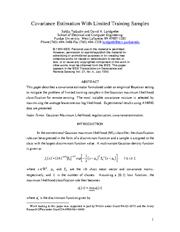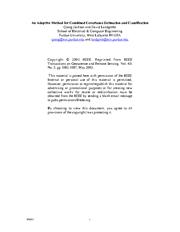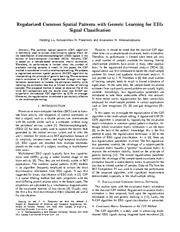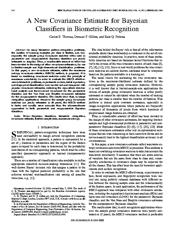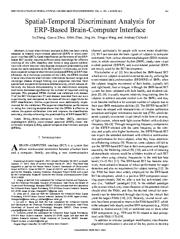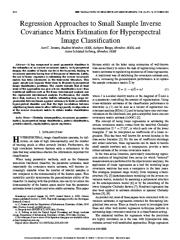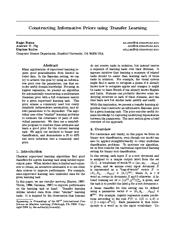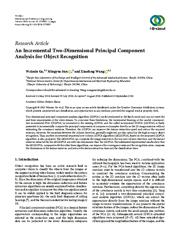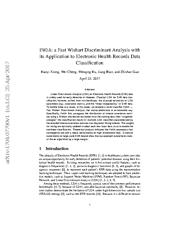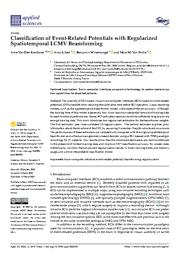A copy of this work was available on the public web and has been preserved in the Wayback Machine. The capture dates from 2017; you can also visit the original URL.
The file type is application/pdf.
Filters
Covariance matrix estimation and classification with limited training data
1996
IEEE Transactions on Pattern Analysis and Machine Intelligence
A new covariance matrix estimator useful for designing classifiers with limited training data is developed. ...
In experiments, this estimator achieved higher classification accuracy than the sample covariance matrix and common covariance matrix estimates. ...
Acknowledgments: The authors would like to thank Jerome Friedman for supplying source code for the RDA algorithm and Wei-Liem Loh for an insightful discussion about covariance matrix estimation. ...
doi:10.1109/34.506799
fatcat:7qq2hcc5xbbhzibi3acm5yp2am
Covariance estimation for limited training samples
1998
IGARSS '98. Sensing and Managing the Environment. 1998 IEEE International Geoscience and Remote Sensing. Symposium Proceedings. (Cat. No.98CH36174)
This paper describes a covariance estimator formulated under an empirical Bayesian setting to mitigate the problem of limited training samples in the Gaussian maximum likelihood classification for remote ...
The most suitable covariance mixture is selected by maximizing the average leave-one-out log likelihood. Experimental results using AVIRIS data are presented. ...
data with limited training samples. ...
doi:10.1109/igarss.1998.702320
fatcat:nuajjckvxndkxhksesdcgwj4ra
Covariance estimation with limited training samples
1999
IEEE Transactions on Geoscience and Remote Sensing
This paper describes a covariance estimator formulated under an empirical Bayesian setting to mitigate the problem of limited training samples in the Gaussian maximum likelihood classification for remote ...
The most suitable covariance mixture is selected by maximizing the average leave-one-out log likelihood. Experimental results using AVIRIS data are presented. ...
data with limited training samples. ...
doi:10.1109/36.774728
fatcat:jbb7s5bfirf2dad3mthcukps6y
An adaptive method for combined covariance estimation and classification
2002
IEEE Transactions on Geoscience and Remote Sensing
With hyperspectral data, the proposed adaptive covariance estimators can improve the classification performance dramatically with limited training samples. ...
INTRODUCTION In quadratic maximum likelihood classification, each true class mean vector and covariance matrix are usually unknown and must be estimated by the sample mean and sample covariance matrix ...
doi:10.1109/tgrs.2002.1010895
fatcat:63ztkgfeunbvxjzjzqenn7a2um
Regularized common spatial patterns with generic learning for EEG signal classification
2009
2009 Annual International Conference of the IEEE Engineering in Medicine and Biology Society
However, CSP is based on a sample-based covariance matrix estimation. Therefore, its performance is limited when the number of available training samples is small. ...
The covariance matrix estimation in R-CSP is regularized through two regularization parameters to increase the estimation stability while reducing the estimation bias due to limited number of training ...
The authors would like to thank Fraunhofer FIRST, Intelligent Data Analysis Group (Klaus-Robert Müller, Benjamin Blankertz), and Campus Benjamin Franklin of the Charité -University Medicine Berlin, Department ...
doi:10.1109/iembs.2009.5332554
pmid:19963675
fatcat:a7h7qrz24vgp5bxo3hvgi6bxgy
A New Covariance Estimate for Bayesian Classifiers in Biometric Recognition
2004
IEEE transactions on circuits and systems for video technology (Print)
In order to evaluate the MECS effectiveness in biometric problems, experiments on face, facial expression, and fingerprint classification were carried out and compared with popular covariance estimates ...
Thus, a considerable amount of effort has been devoted to the design of other covariance estimators, for use in limited-sample and high-dimensional classification problems. ...
However, MECS new covariance approach shows that, in high-dimensional classification problems where limited training sample sizes are provided, the problem of estimating covariance matrices for nonconventional ...
doi:10.1109/tcsvt.2003.821984
fatcat:kiuljlcfcjbovmovjqmvs4knga
Spatial-Temporal Discriminant Analysis for ERP-Based Brain-Computer Interface
2013
IEEE transactions on neural systems and rehabilitation engineering
Good classification performance of the ERPbased BCI usually requires sufficient data recordings for effective training of the LDA classifier, and hence a long system calibration time which however may ...
The proposed STDA method was validated with dataset II of the BCI Competition III and dataset recorded from our own experiments, and compared to the state-of-the-art algorithms for ERP classification. ...
For ERP classification, the required number of parameters for the covariance matrix estimation is typically much larger than the number of training samples recorded from limited calibration time. ...
doi:10.1109/tnsre.2013.2243471
pmid:23476005
fatcat:w2nhj6calzcjzh4n3egr6zrc4i
Regression Approaches to Small Sample Inverse Covariance Matrix Estimation for Hyperspectral Image Classification
2008
IEEE Transactions on Geoscience and Remote Sensing
A key component in most parametric classifiers is the estimation of an inverse covariance matrix. ...
Lately, the use of linear regression in estimating the inverse covariance matrix has been introduced in the time-series literature. ...
INTRODUCTION H YPERSPECTRAL image classification operates, by definition, on data of high dimensionality, and the number of training pixels is often severely limited. ...
doi:10.1109/tgrs.2008.2001169
fatcat:fd2vyjsfnzd3xdqulqaids3h7u
Regression approaches to small sample inverse covariance matrix estimation for hyperspectral image classification
2007
2007 IEEE International Geoscience and Remote Sensing Symposium
A key component in most parametric classifiers is the estimation of an inverse covariance matrix. ...
Lately, the use of linear regression in estimating the inverse covariance matrix has been introduced in the time-series literature. ...
INTRODUCTION H YPERSPECTRAL image classification operates, by definition, on data of high dimensionality, and the number of training pixels is often severely limited. ...
doi:10.1109/igarss.2007.4423666
dblp:conf/igarss/JensenBS07
fatcat:m74ymwvugna6niujavtix6xde4
Constructing informative priors using transfer learning
2006
Proceedings of the 23rd international conference on Machine learning - ICML '06
Many applications of supervised learning require good generalization from limited labeled data. ...
Focusing on logistic regression, we present an algorithm for automatically constructing a multivariate Gaussian prior with a full covariance matrix for a given supervised learning task. ...
Acknowledgments We give warm thanks to Chuong Do for providing the DMOZ data, and Penka Markova for useful comments. ...
doi:10.1145/1143844.1143934
dblp:conf/icml/RainaNK06
fatcat:kb3in4gus5gbbfmuorba4iwqwe
An Incremental Two-Dimensional Principal Component Analysis for Object Recognition
2018
Mathematical Problems in Engineering
matrices, and reduce the feature extraction time and the classification time. ...
To overcome these limitations, the incremental learning of the candid covariance-free incremental PCA (CCIPCA) is innovated to the existing 2DPCA, and the called incremental 2DPCA (I2DPCA) is firstly presented ...
If we incorporate additional training data into the existing projection matrix, the matrix has to be retrained with the whole training data. ...
doi:10.1155/2018/3272809
fatcat:dnvedbtorradppd5qtv45d3vim
FWDA: a Fast Wishart Discriminant Analysis with its Application to Electronic Health Records Data Classification
[article]
2017
arXiv
pre-print
Classical LDA for EHR data classification, however, suffers from two handicaps: the ill-posed estimation of LDA parameters (e.g., covariance matrix), and the "linear inseparability" of EHR data. ...
Specifically, FWDA first surrogates the distribution of inverse covariance matrices using a Wishart distribution estimated from the training data, then "weighted-averages" the classification results of ...
TheΣ is the covariance matrix estimated from data x 1 , x 2 , ...x n . ...
arXiv:1704.07790v1
fatcat:lkomm3ch5vcr7hjy3r5k7lao2a
Early Detection of Disease Using Electronic Health Records and Fisher's Wishart Discriminant Analysis
2018
Procedia Computer Science
Specifically, FWDA first surrogates the distribution of "potential" inverse covariance matrix estimates using a Wishart distribution estimated from the training data. ...
Specifically, FWDA first surrogates the distribution of "potential" inverse covariance matrix estimates using a Wishart distribution estimated from the training data. ...
The is the covariance matrix estimated from data x 1 , x 2 , ..., x n . ...
doi:10.1016/j.procs.2018.10.299
fatcat:7jrrobay6jdbdgrb5zsqqrbrkm
Covariance matrix estimation for appearance-based face image processing
2005
Procedings of the British Machine Vision Conference 2005
Sample scatter matrices are unreliable estimators of class covariances, yet many methods rely on them for dimensionality reduction and often for classification too. ...
The method is demonstrated for face detection, where a maximum likelihood classifier trained with regularized covariances achieves discrimination and detection results comparable to those of complicated ...
With good estimations, ML classification provides a viable baseline for face detection (for example), as section 5 shows.
2 Covariance matrix estimation
Notation and assumptions Suppose that each of ...
doi:10.5244/c.19.43
dblp:conf/bmvc/Robinson05
fatcat:yktn6ipoqvfaxlhqnhgoc5sq5m
Classification of Event-Related Potentials with Regularized Spatiotemporal LCMV Beamforming
2022
Applied Sciences
Our results show that the introduced estimators are well-conditioned in the presence of limited training data and improve ERP classification accuracy for unseen data. ...
The performances of these estimators are validated and compared with the original spatiotemporal beamformer and a Riemannian-geometry-based decoder using a BCI dataset with P300-paradigm recordings for ...
Acknowledgments: The authors acknowledge François Cabestaing and Hakim Si-Mohammed for their valuable input in the development of this article. ...
doi:10.3390/app12062918
fatcat:43ydistlj5gkpd25tgjmmavaoi
« Previous
Showing results 1 — 15 out of 79,313 results

